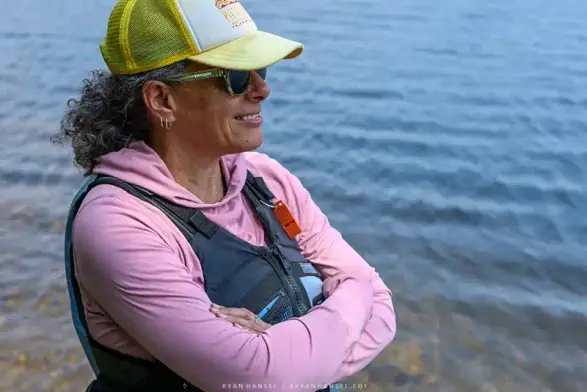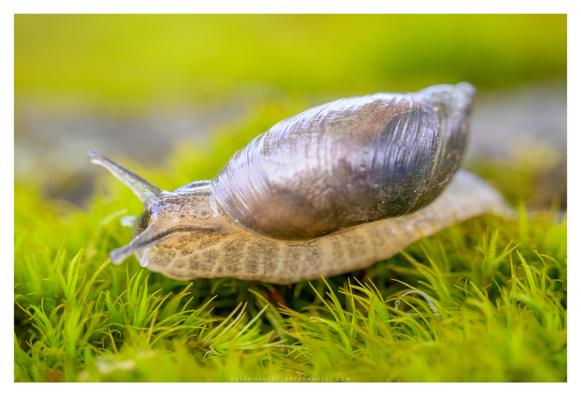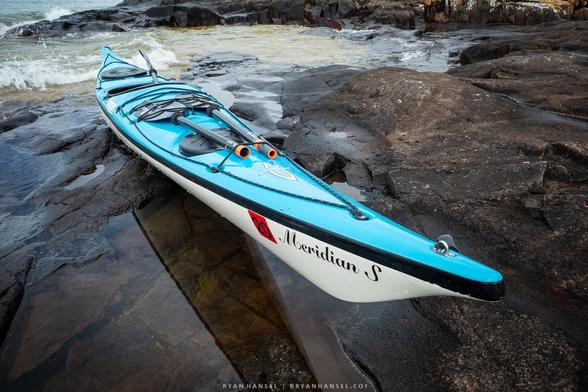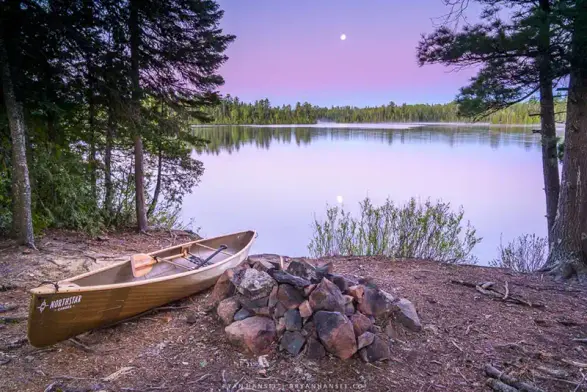The Dagger Meridian: One of America's Best Sea Kayaks
In 1996, Dagger introduced their first composite sea kayak using techniques they had developed to build whitewater slalom kayaks. It was one of the first British-style kayaks made commercially in the US for the US market and that placed it squarely in competition with the NDK Romany, which would have been one of the most popular British-made boats sold in North America at the time. It had a big target, and I think it succeeded. The Dagger Meridian is still one of the best designed British-style kayaks of all time, and this is its story as I know it. We may earn commissions if you shop through the links below. The research for this article was done for an article that I wanted to write for PaddlingLight and pitch as a potential column about historic sea kayak designs for Ocean Paddler Magazine. From a personal perspective, I wanted it to replace my column on navigation, which I was getting close to finish writing. I envisioned multiple authors researching older designs and writing about their favorites. The Dagger Meridian has always been one of my favorite kayaks, and it was the first kayak that I researched. While the column never materialized and the magazine folded, I wanted to publish the interviews that I got. All were conducted via email. I never completed a draft of the article, so this post will be more about getting this information out there than writing a pretty article. Handles well in conditions ranging from flat calm to steep chop…” National Geographic Adventure Magazine My History With the Dagger Meridian Back in 1997 when I bought my first sea kayak, I drooled over the Meridian as it stood in a shop next to a Magellan in a shop that I worked at. Unfortunately, I couldn’t afford the composite boat because I was a broke dirtbag rock climber. The Magellan had a blem in it, and when I pointed it out, the rep managed to get me a good price. I couldn’t refuse. The Meridian never sold at full price and sat in the shop for over a year. When it sold, it sold for about what I paid for the Magellan. I wish I would have waited. It took me about 20 years before I actually owned one. I bought two used Dagger Meridians sight unseen from a small shop near Des Moines, Iowa. They stored them for a month or so before I could pick them up. I ended up with the color (blue) and layup (Kevlar) that I wanted. I got the skeg, but not the day hatch (which I wanted). It was also the small version of the boat, which I also wanted. The second was a fiberglass model in orange, with a skeg, day hatch, and it was the standard size. I still have both but might consider selling the orange one to someone who would appreciate what they own and for the right offer. Catalog Descriptions When the kayak was introduced, this is how it was described in the catalog by Crandall Caughman,Composites Fabricator for Dagger, “The flagship of our sea kayak line, the Meridian is a compositeboat, executed in West Greenland style combining traditional aesthetics with state-of-the-art hull design and construction. Built by Dagger Composites much like our world-class slalom racing boats. (We supply many of the U.S. Whitewater team members are essential.) It has a shallow arch midship hull section for excellent stability and “V” shaped ends that knife through the chop, smooth your ride, and keep you tracking on course. Day trips are a joy in this personalsized boat yet its ample carrying capacity makes multi-day trips easily doable. The generous, comfortable cockpit with supportive seat and form fitting thigh braces aid rolling and surfing. This is a boat for discriminating paddlers of all skill levels.” While the marketing copy in Dagger’s catalogs changed over the years, I think the copy in 1998 most accurately describes the kayak’s performance, “The funhog of sea kayaks, paddlers are wowed by the Meridian’s turning ability and responsiveness without a sacrifice in hull speed or tracking. Its unique performance is born from the pronounced vee at the bow and stern ends with a shallow arch midship. This new twist on the classic West Greenland design provides an ultra-smooth ride, even in the big chop, and the easily accessible hatches provide enough storage for multi-day tripping. Beautiful lines, top quality materials and lay-up, plus Dagger’s trademark attention to detail sum up one of the lightest,stiffest turning kayaks of its kind.” I thing they mention about the material construction is worth calling out, because compared to British kayaks at the time, Daggers layups were ahead of its time. Eventually the catalogs became more pure marketing fluff instead of good descriptions of the features and benefits like the earlier catalogs. Available Configurations When launched the Meridian came in two configurations: Standard and Sleek Deck. The Sleek Deck model was sold without hatches or decklines, and as far as I can tell didn’t stay in the lineup for 1997. It included flotation interior attachment loops, bow & stern floatation. A day hatch was an option, but it wasn’t installed in a molded recess, but instead was installed flush with the rear deck with a waterproof bag hanging off of it. There wasn’t an additional bulkhead separating the day hatch area from the rear compartment like in British sea kayaks and some of Dagger’s other boats. In 1998, a retractable skeg was added as an option. The skegged versions were designated Meridian SK. While I can’t confirm the exact timing, a cut-down version was added in the 2000 catalog. It may have been available as an option before then. They cut the deck down an inch to make a smaller version for smaller paddlers. The smaller version made the deck height more inline with a NDK Romany’s height. In 2001, they added the -S designation to the cut-down version for smaller paddlers. By that point, there were four models available: Meridian, Meridian S, Meridian SK, Meridian SK-S. 2004 was the last year that the Meridian was produced by Dagger. By that time, the company had been bought out and the focus shifted into plastic boats using traditional rotomolded plastic and Airalite. If I remember right, they were first bought by a Saudi-backed company, because one of their competitors was giving them a hard time about it right after 2001. In 2005, Confluence purchased Watermark, which owned Dagger at that time. The company has changed hands a number of times since then and is currently owned by Pelican International, which is a Canadian company. Specifications from the Catalogs Length: 16′ (488 cm)Width: 22″ (56 cm)Weight: Comp 54 lbs. (24.5 kg)Kevlar 46 lbs. (21 kg)Cockpit: Length 31.5″ (80 cm), Width 16.5″ (42 cm)Recommended maximum load: Paddler and gear – 280 lbs. (127 kg)Hatch Volume (bow/stern): 3700in3/6200 in3 (61/102 liters) Outfitting for Meridian Standard and Meridian SD includes: Deluxe PD Designs back-band, full comfortable seat keyhole cockpit with built-in neoprenepadded thigh braces, adjustable foot braces, carrying toggles, mounted water- bottle holder under deck with water bottle, shock cord deck rigging with additional deck lines no leak Kajak Sport hatches from Finiand, installed fiberglass bow and stern bulkhead, recessed compass mount, recessed deck fittings Other Accessory Option: Day hatch with gear bag Colors: Purple, ivory, light blue, high optic yellow, red, orange and other colors through the years Rumors of Copying the NDK Romany While I’m not going to go back and find the old threads on Paddling.net, there were often rumors stating that the Meridian was basically a copy of the NDK Romany. That didn’t seem likely to me considering that we had station views of both of the kayaks from Sea Kayaker Magazine, and while similar, they weren’t the same. You can see that below with the Meridian on the right. The above image is the Meridian station plans as appeared in Dagger catalog. To my eye it looks different than the lines taken by Sea Kayaker Magazine. Speaking of Sea Kayaker Magazine, they reviewed it in the June 1996 issue. Here is the technical data page. The Interviews About the Dagger Meridian I’m going to leave these answers in full as they were given to me. I reached out to multiple people who I had worked with at Dagger when I was a buyer for one of their dealers. I didn’t hear back from everyone. I really wanted to hear back from Fritz Orr, who currently makes amazing canoe paddles, because of Steve’s answer and any insights that he might have had. The column never got off the ground, so I didn’t revisit this until now. Maybe some day, I’ll be able to get his Fritz’s story. From Steve Scarborough, one of the founders of Dagger: I can give you a quick memory much dimmed and therefore rendered unreliable by the many (22?) years. Dagger had an excellent composite facility put in place by Andy Bridge to build whitewater Olympic boats and was looking to move into composite sea kayaks. We did our research, paddling pretty much every boat we could get our hands on, and, since TN doesn’t have an ocean, we ate a lot of seafood in Maine, Seattle, and all along the southern coast particularly along the islands of South Carolina. There were several British boats that were popular at the time and our dealers wanted something in that genre. All of them had vee hulls and I am just not a fan of the vee as a cross section. I worked on a hull that would be playful and comfortable for day trips and medium trips, since frankly that was what we found that most people did with their boats, even though everyone has fantasies of some sort of expedition that they will most likely never take. I have always been a form follows function designer but we made some concessions to the “Greenland” style profile and put our whitewater “keyhole” cockpit on the boat. I built the wood strip prototype with a shallow arch cross section and we paddled it a good bit in coastal waters before blessing the final version. (It wasn’t only me. Lot’s of Team D folks had their say in the design process as usual) I got my butt kicked on Folly Beach by the Hurricane Felix storm surf with Joe Pulliam and Rob Kelly there to save me, but we had a blast of a good time. The thigh braces were actually molded on Fritz Orr’s thighs while he sat patiently in the seat while the resin hardened. Fritz did the plug work and there you have it. It has a low prismatic coefficient compared to the British designs and is quite playful as a result. It does hit a wall if you push it in race mode but that is the concession a designer has to make. Before I walked out of the boat business I bought two Meridians and still have them. I have six different sea kayak designs in my fleet but the Meridian gets more use by far than any of the others. Joe Pulliam, one of the founders of Dagger: Wow, wish I could remember all the details. Here’s what I do recall. Dagger was still primarily a whitewater kayak and canoe company at the time, but we had done three or so plastic touring/sea kayaks. We had recently purchased Valley Mill Boats, a small composite boat company outside of D.C. that made primarily slalom and some wildwater racing kayak designs. Andy Bridge, the owner, moved his business down to a building we had built specifically to house a composites shop, and also to use as new home for R&D for Dagger. We knew that we wanted to also build composite sea kayaks to justify the investment, and I’m quite sure the Meridian was the first one. We had paddled and conversed quite a bit with one of the noted British sea kayakers...








